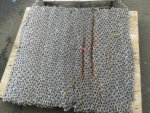mdrifter
New member
In 2006 I bought 60m of 8mm uncalibrated galvanised anchor chain and I'd like to say it has served me well but I really don't think so. It was bought from a British manufacturer who has a hot dip galvaniser close at hand. Having been sailing away from the UK since 2007 and having anchored modestly (I have recorded the exact number of occasions) I have decided to jettison the lot because of the degree of rusting that has occurred in several sections. I don't think it has been stored aboard or ashore in unusual conditions nor has it been used excessively. Perhaps this is a can of worms best left unopened but I'd be interested in other opinions and of course from where should I seek its replacement, please?

